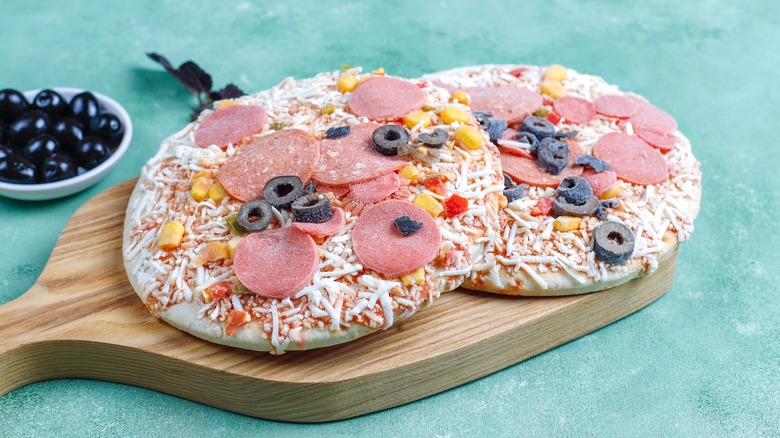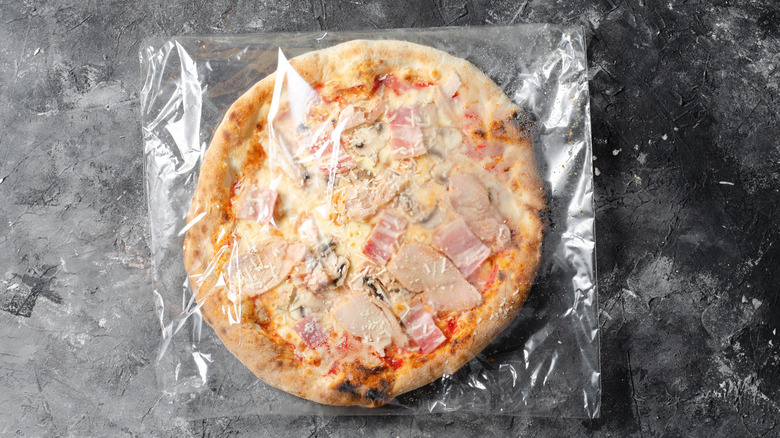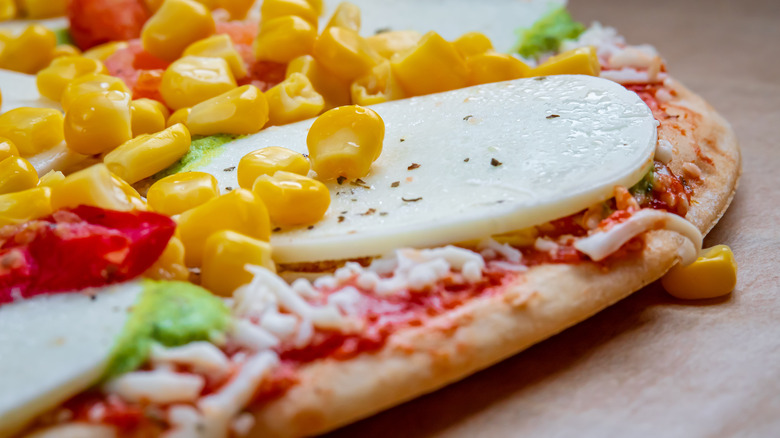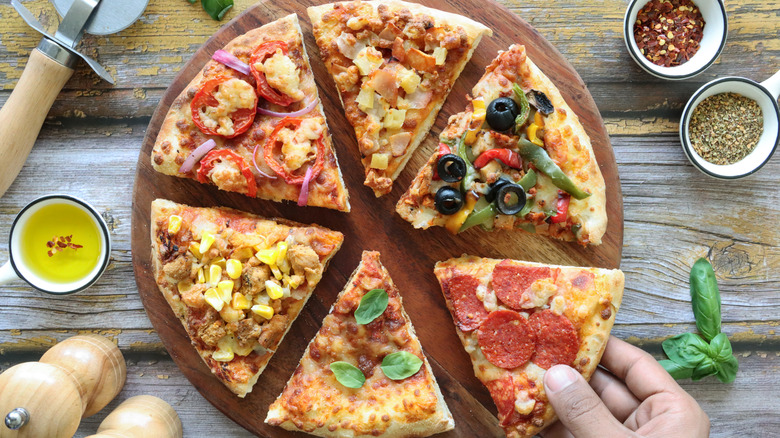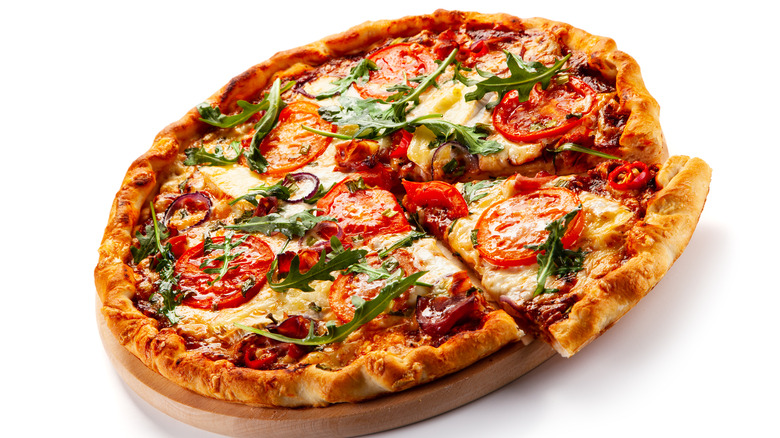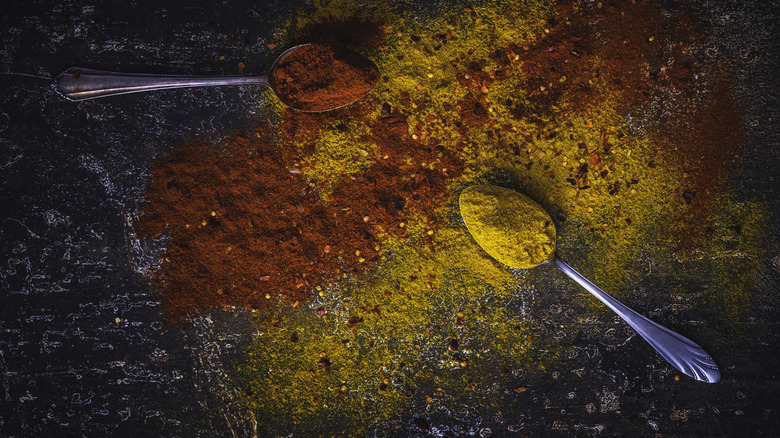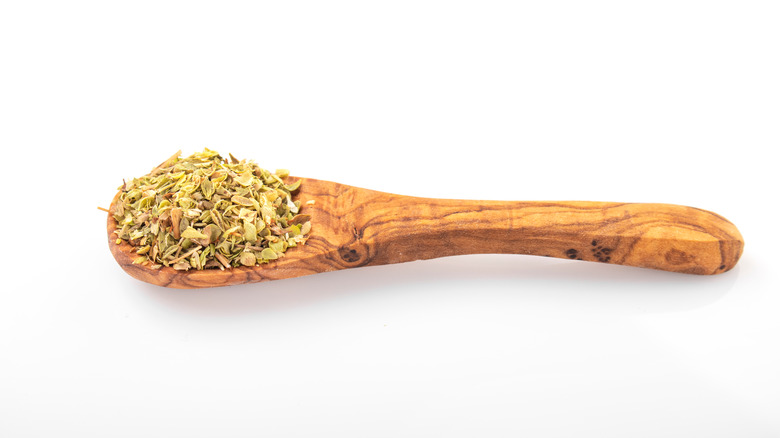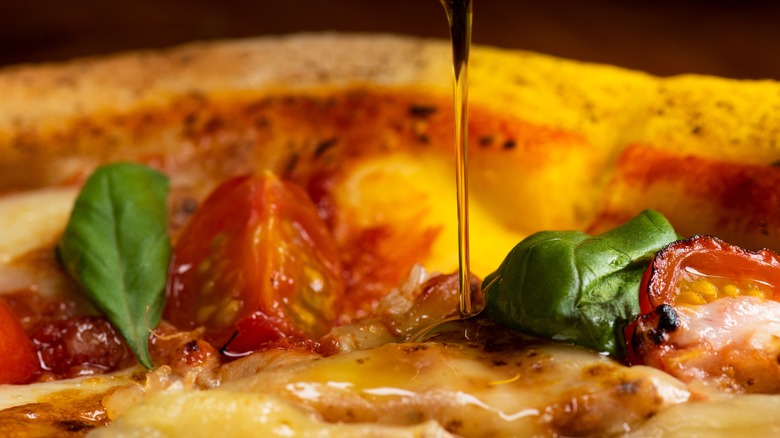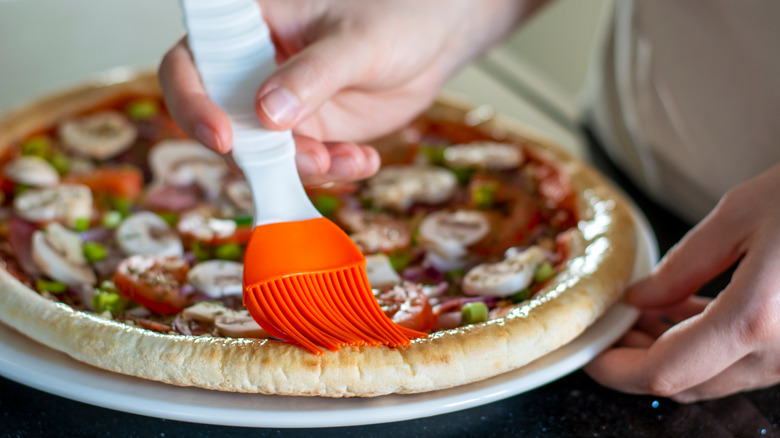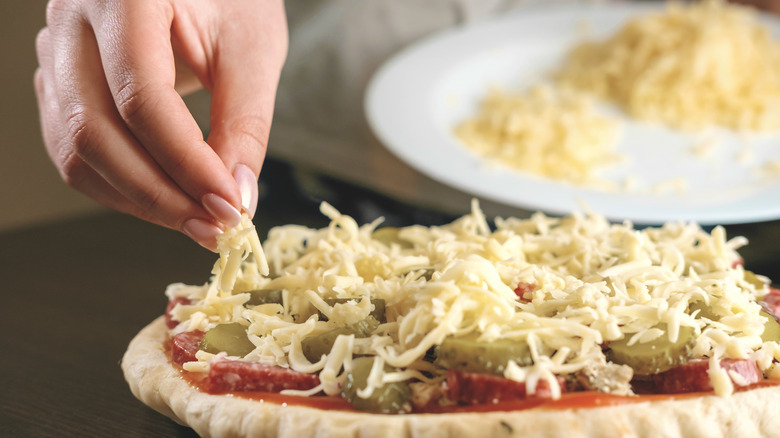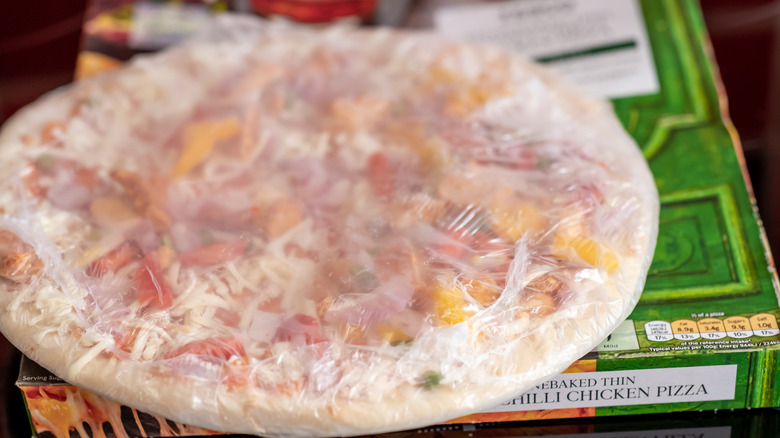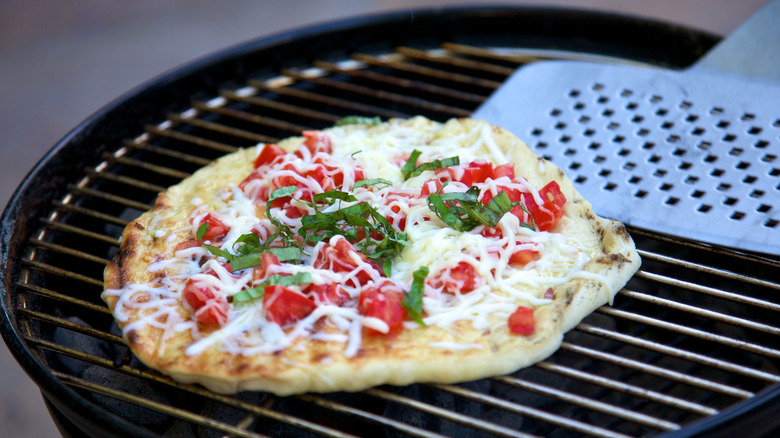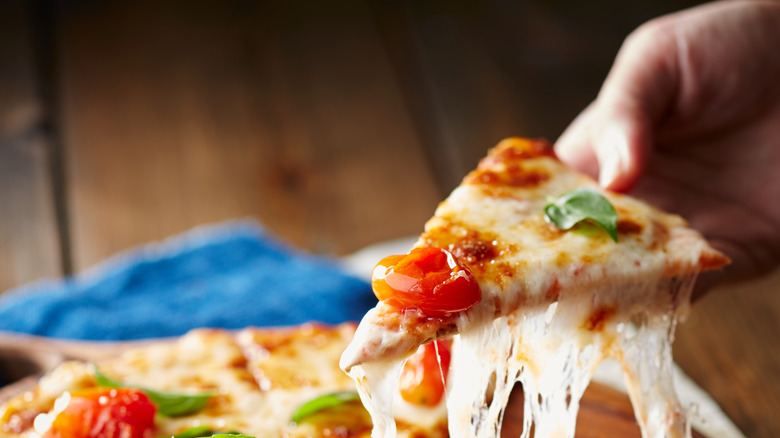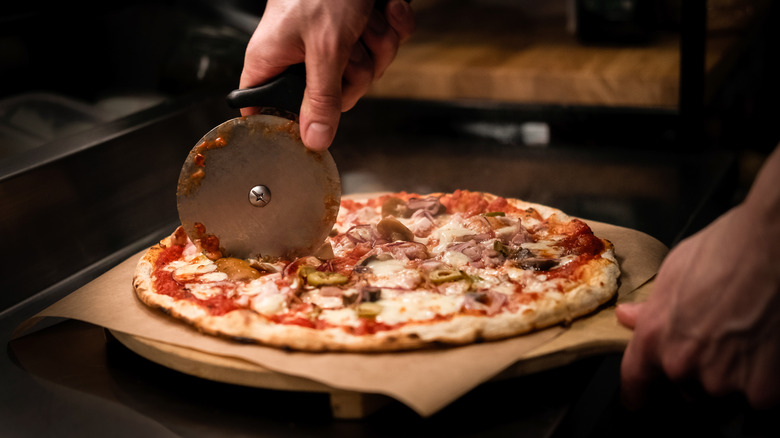13 Ways You're Messing Up Your Frozen Pizza
It may seem impossible to mess up one of God's greatest creations, frozen pizza from a box, but there are actually some definite dos and don'ts when it comes to preparing the perfect pie from the freezer section. Frozen pizza may seem like a lazy man or woman's meal, but with the tiniest bit of extra effort that anyone can easily put forth, the final outcome can be so much tastier.
We're dissecting some common errors that people make when preparing a frozen pizza and what you should look out for the next time you treat yourself to some cheese on bread from the frozen food aisle. You might even be able to claim pizza chef status after avoiding certain pitfalls and instead employing some tried and true hacks. Read on to learn the top eight ways you are possibly screwing with potential perfection so you can avoid these no-no's the next time you treat yourself to your favorite brand of frozen dough, sauce, and cheese.
1. Not thawing the pizza before putting it in the oven
Frozen pizza is mainly praised for its convenience, as it typically takes 20 minutes to get from the freezer to the table. But this speedy process is one way you're messing up your frozen pizza. Despite what the instructions say, you will get much better results if you thaw your pizza beforehand. Even half an hour can make a significant difference in texture and flavor.
Frozen pizza generally does not contain much moisture and often comes out of the oven dry and hard. By leaving it to thaw, it will soak up some water from the frozen crystals, resulting in a softer and more pliable dough. If the pizza goes straight to the oven, all the potential moisture will immediately evaporate, giving your frozen pizza that familiar dry texture. Nevertheless, make sure not to leave it out too long as a thin crust will quickly become too soggy.
The reason the label on the pizza box suggests directly shoving frozen pizza in the oven is for food safety. As the U.S. Department of Agriculture explains, the safe zone where food bacteria usually cannot multiply is between 40 and 140 F — implying that the typical route from the freezer to the oven is the safest option health-wise. However, thawing your pizza in the refrigerator will still leave it out of the danger zone, so this might be the best compromise for food safety, flavor, and texture.
2. Not reassembling the pizza toppings before cooking
Sometimes when you pull the frozen pizza out of the box and remove the plastic sleeve that's usually encasing it, the toppings are all awry so your instinct might be to just shove them all back to the center, or get them scattered as evenly across the surface as possible if they've all slunk to one side. Even if this topping side shift hasn't happened when you pull the pizza out, it's actually still a good idea to methodically rearrange the toppings before baking it.
If you envision where the cutter is going to slice through when the pizza is frozen, you can easily assemble the toppings so that you guarantee space for a "clean cut" when you slice. If you employ this hack correctly, when you slice the pizza, the pizza cutter doesn't have to cut through anything except the bread, sauce, and cheese. Your future self that's going to be cutting this pizza into slices will thank you since this trick yields a lot less mess and whole pepperonis still intact.
3. Not dressing it with toppings before and after baking
Frozen pizza does not ooze luxury or abundance. The dough is usually mediocre at best, and even the top brands don't go wild with toppings. In most cases, the garnishes are scarcely distributed and sometimes of questionable quality. However, this potential problem has a straightforward solution; just tweak, adjust, and improve the toppings for a better frozen pizza experience.
Play with textures and flavors, but don't go overboard and smother the whole thing, or else the dough will not bake correctly. The easiest solution is to add more cheese and cured meat but feel free to reach for leftovers that could work too. If you want to add an umami element, anchovies are the perfect option. Also, don't forget about pickled and canned ingredients. They are a very convenient way to add contrasting flavors and improve the texture.
Don't limit the additional toppings to the pre-baking stage. Some garnishes will work better if you add them after you've baked your frozen pizza to retain their texture and freshness. This includes leafy greens (arugula usually goes exceptionally well with pizza), thin strips of salty prosciutto, and finely sliced mortadella.
4. Not prepping extra vegetable toppings
Adding extra vegetable toppings to frozen pizza isn't necessarily a bad idea but you can really mess up the final product if you don't do a little prep work on the veggies prior to adding them. Basically, the vegetables need to be sliced, softened, and/or roasted first, and the exact prep will depend on the vegetable.
For instance, mushrooms can end up disastrous if you don't sauté them with some butter first to soften them; onions will emerge even more raw-seeming than before if you don't sweat them prior to adding them on top of the pizza, and bell peppers should, in a perfect world, be both skinned and roasted in advance of going onto the pizza. So while adding vegetables to a plain cheese frozen pizza might seem like an easy add-on, you should definitely take the time to chop and slice everything as finely as possible, in addition to assessing the type of vegetable and how it is ideally pre-cooked, before you go crazy with these DIY toppings.
5. Not spicing it up
One of the most common mistakes people make with frozen pizza is ignoring the wonderfully diverse spice rack in their home kitchens. This is one of the easiest ways to amp up the flavor of frozen pizza, which is often tasteless and forgettable.
Salt is the most underestimated seasoning when it comes to frozen pizza. It contributes to flavor but also helps with overall balance and does a great job at enhancing all other taste components. Most types of salt can be used, but smoked or flavored salt would work exceptionally well sprinkled on top of pizza. Chili flakes are a standard condiment at pizza joints, but we forget they can add heat and flavor to frozen pizza too. For an easy upgrade, sprinkle hot or smoky paprika on top to infuse your pie with earthy aromas. Also, don't forget Indian or Middle Eastern spices if you have garnishes that complement them nicely.
Before adding any spices, think of the pizza toppings you're working with and adjust the seasonings accordingly. The aim should be to create a harmonious and balanced dish with more flavor than you would find in a standard frozen pizza. Add as much or as little as you like, and decide whether you want to sprinkle the spices as a finishing touch or pre-bake.
6. Skipping the addition of more herbs
Part of the appeal of frozen pizza is all the hard work is done for you. It's convenient and quick already so why add more work? Well, certain tweaks are less than a minute of work so they're worth the effort. You can actually take the frozen pizza from mediocre to Insta-worthy by supplying the pie with an extra dash of herbs prior to cooking it.
Oregano is an excellent accompaniment to a dish with tomato sauce as the base, and frozen pizza is no different. Add some dried or fresh oregano to frozen pizza to enhance the flavor. Thyme is also a great add-in because it's kind of sweet and therefore a nice contrast to the savory cheese on the pizza. Garlic makes everything better but it's technically a vegetable unless you want to go with the powdered kind, in which case we'll toss it in as a contender for the added herbs on pizza. A little salt and pepper never hurt either.
7. Skipping the olive oil drizzle
A swirl of olive oil is the minimum effort needed to make your frozen pizza taste better. It's sure to improve a dry texture while infusing extra flavor. However, to avoid ending up with a soggy pizza base, brush the bottom crust with olive oil before baking. As it bakes, it will turn the moist crust into a thin, crispy shell sturdy enough to carry all those toppings without breaking. Another option is to simply drizzle olive oil on top of the pie. You can be more generous with the edges, but even a touch of olive oil will provide tons of flavor to the dough. It will also prevent the pizza from drying and protect your toppings from scorching.
If you don't want to add it beforehand, olive oil is also an excellent addition to pizza right out of the oven. This is a great method if you want the aroma and flavor of olive oil to be more prominent. In both cases, make sure to use good quality oil, and if you are adding it as the finishing touch, it's best to go with extra virgin due to its fresh profile and bright flavors.
8. Leaving the crust unattended
Frozen pizza gets some flavor from the toppings, but the dough is usually bland, neutral, and subpar. This might not be a problem if you pair it with sauce, cheese, or pepperoni, but the crust around the pizza does not have the privilege of blending with other ingredients, and the result is usually an uninteresting, thick slab of dough that would benefit from any intervention. Leaving it unattended will lead to a disappointing experience.
The easiest route for a better-tasting crust is to brush it with melted butter or olive oil. Both ingredients will impart rich flavors and nuanced aromatics, but they will also turn the cardboard dry dough into a crispy crust that you will actually want to eat. You can also use flavored oil for an extra boost of flavor, such as by adding finely sliced garlic or crushed chili peppers. For even tastier results, melt herb-packed compound butter and generously coat the crust. This will add a medley of flavors to the dough, possibly making it the best part of your frozen pizza. A sprinkle of cheese is a good idea too, and it will easily adhere to the oil or butter-brushed crust and bake into a crispy, cheesy delight.
9. Adding extra cheese incorrectly
There is nothing wrong with wanting to add some extra cheese to a frozen pizza but there is definitely a wrong way to do it. It's important to keep that in mind when you add the extra cheese. Try sprinkling it on halfway through the cooking process, but the placement can also depend on the type of cheese you're adding. For example, most frozen pizzas already come with a layer of shredded mozzarella so if you're going to add more of that, you can probably get away with it before you place the pizza in the oven. However, if things are really getting wild at your house and you're adding cheddar cheese to the frozen pizza, it cooks a lot faster so you may want to add it on when you hit the halfway mark of baking.
Sometimes people mess up with the addition of cheese when it's the wrong kind of cheese. Cheeses that tend to be "wetter" such as burrata or buffalo mozzarella are more likely to "sweat" and impact the crispiness of the crust. Certain hard cheeses release a lot of liquid, too. Just be thoughtful about how you add the extra cheese so you don't negatively affect the quality of your pie.
10. Baking the pizza at the temperature suggested on the box
It might sound counterintuitive to not follow the exact instructions on the side of the frozen pizza box but hear us out on this one. You know how pizzeria pizza is always the perfect texture of crust combined with cheese melted to the ideal consistency? A big component of how they pull that off in restaurants is an industrial oven that's designed to get extremely hot for cooking pizzas. You can replicate this at home without an official pizza oven if you crank up the temperature of your kitchen's oven to 550 F. Then just bake the pizza for about five to eight minutes, as opposed to the usual 12 to 15 minutes.
A pizza stone is the ideal way to cook a pizza in this extreme heat, but if you don't have one of those, try placing the pizza directly on the rack instead.
11. Baking the frozen pizza instead of grilling it
One of the most basic ways you might be screwing up your frozen pizza is not utilizing the grill (if you've got one). Sure, the oven is the standard go-to for cooking a frozen pizza but the grill is virtually just as easy and the results might really wow you.
This hack works best with a 10-inch pizza. Make sure the grill is preheated for about 15 minutes on the high setting. Then add the frozen pizza, reduce the heat, and cover the grill. Keep watch on it, but the cooking time frame should be about 10 to 12 minutes. Place the grilled pizza onto a cutting board with a spatula as soon as the cheese has fully melted and you see that good char has developed around the crust.
Grilling a frozen pizza, if you have access to a grill, can really give it that pizza parlor quality even though you bought it on sale at the grocery store because you're too tired to cook or to change into real pants to eat at a restaurant — everybody wins.
12. Not using a pizza stone
Pizza stones may seem like the tools of advanced pizza chefs, not someone popping in a pepperoni DiGiorno at home, but they are actually a very easy way to enhance the taste of any frozen pizza too. Pizza stones serve to imitate the magic of a real-deal brick oven that a legit pizza place would use because the stone easily takes in high heat then keeps that heat in for an extended time. The term "stone" is a bit of a misnomer since pizza stones are actually made of clay that's unglazed.
If you are going to use a pizza stone with a frozen pizza, make sure to preheat the stone in the oven for at least 30 minutes after the oven has reached the temperature you set it to and to let the pizza thaw to room temperature before you place it on the hot stone. Having a pizza peel on hand would also be helpful for safely retrieving the hot, hot pizza from the stone when it's done.
13. Cutting the pizza too soon after it comes out of the oven
While it may be tempting to slide that pizza cutter right into that pie as soon as you pull it out of the oven because, well, you're starving and really want pizza, try to hold off on cutting into it too soon. There are a few reasons why you might mess up the pizza if you cut into it the minute it's done.
For one, the cheese and toppings need a chance to set. The suggestion from The Kitchen Warriors is to let the pizza sit at room temperature for just three minutes (you can totally handle three minutes) before cutting into it. That way the toppings and cheese are still piping hot but set enough to where you won't pull the pizza cutter up with a boatload of melted cheese along with it. We all know that mess. Also, when you cut into the pizza too soon, you run the risk of the oil from the cheese running into the crust, soaking it, and therefore affecting the crispiness (it'll be less crispy). Nobody in their right mind likes a soggy pizza crust.
Oh, and also, your pizza isn't gonna taste as good if the roof of your mouth is burned, so it's best to wait if you can.
